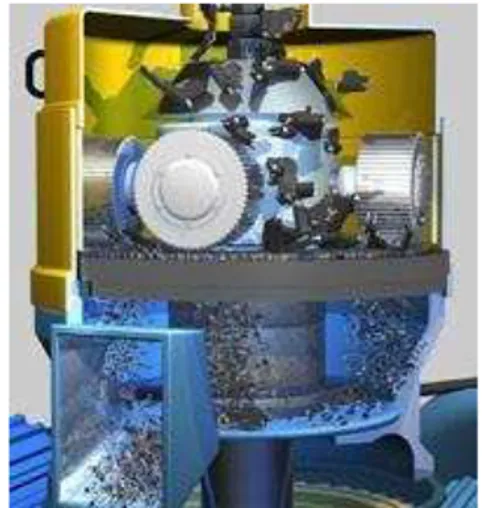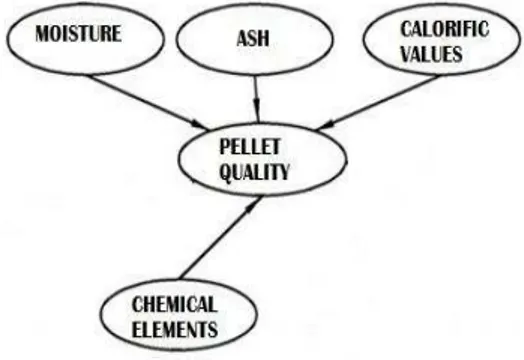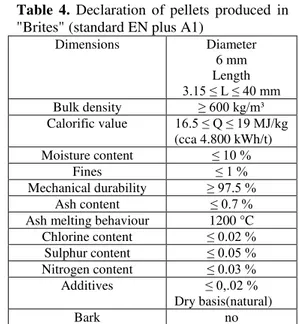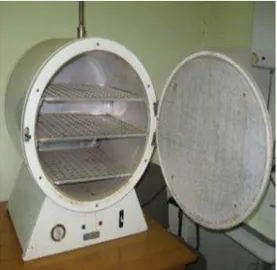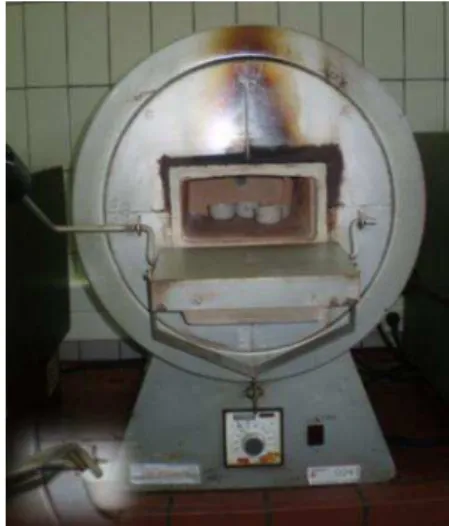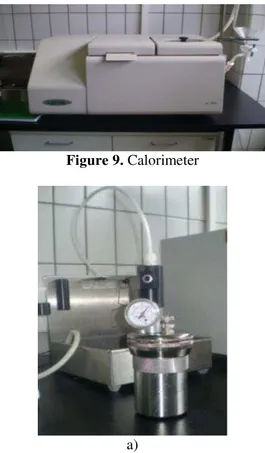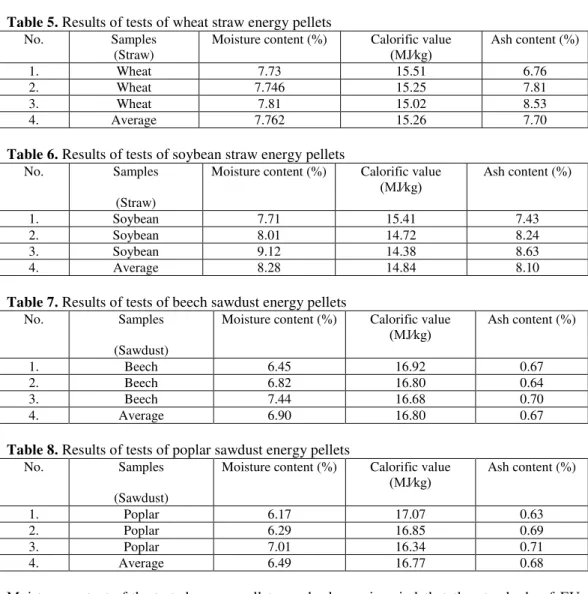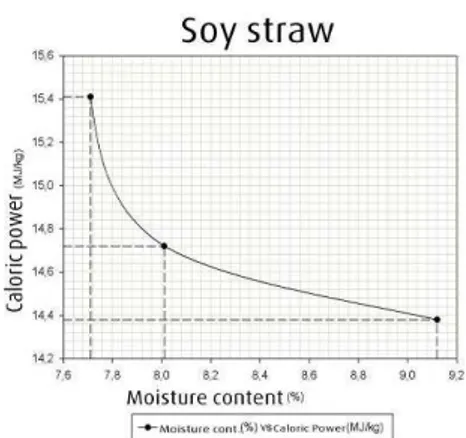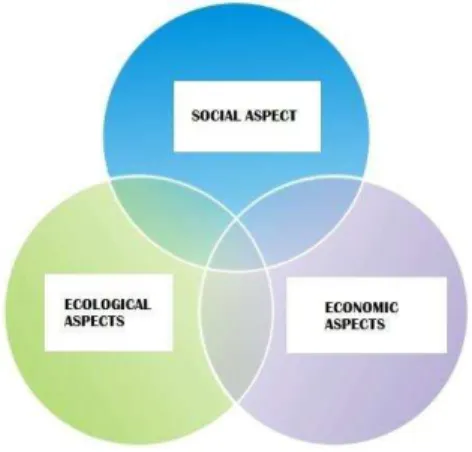International Journal for Quality Research 8(3) 385-398 ISSN 1800-6450
Zorica Gluvakov
1Slavica Prvulovic
Zlatko Kosut
Sasa Igic
Miladin Brkic
Article info: Received 19.06.2014 Accepted 17.09.2014 UDC – 54.061
ANALYSIS OF THERMAL-CHEMICAL
CHARACTERISTICS OF BIOMASS ENERGY
PELLETS
Abstract:
In modern life conditions, when emphasis is on
environmental protection and sustainable development,
fuels produced from biomass are increasingly gaining in
importance, and it is necessary to consider the quality of
end products obtained from biomass. Based on the
existing European standards, collected literature and
existing laboratory methods, this paper presents results
of testing individual thermal - chemical properties of
biomass energy pellets after extrusion and cooling the
compressed material. Analysing samples based on
standard methods, data were obtained on the basis of
which individual thermal-chemical properties of pellets
were estimated. Comparing the obtained results with the
standards and literature sources, it can be said that
moisture content, ash content and calorific values are the
most important parameters for quality analysis which
decide on applicability and use-value of biomass energy
pellets, as biofuel. This paper also shows the impact of
biofuels on the quality of environmental protection. The
conclusion provides a clear statement of quality of
biomass energy pellets.
Keywords:
biomass, pellet, moisture content, ash
content and calorific value
1.
Introduction
1Biomass is a primary energy source, and one of the most desirable renewable energy source, due to its low level of carbon dioxide emission and potential sustainability. This can be increased even more, provided that economic, environmental and social impacts
1
Corresponding author: Gluvakov Zorica email: zorica.gluvakov@live.com
are properly managed (Unal and Alibas, 2007).
Biomass includes trees, agricultural and forest residues, human or animal waste, energy crops, organic fraction of municipal solid waste (MSW), food processing wastes, sewage sludge and leachate (Obara et al., 2009).
in a variety of forms, or processed into various shapes for easy and simple use, i.e. simplification and economics of its use. Currently, the most cost-effective form of biomass packaging is a pellet which with its specificities surpasses any other type of packaging. This type of packaging has existed for a long time, and it was first used in mines, where it was used for pressing dust and coal fines (Brkić and Janić, 2008). A pellet (Figure 1) is a small body, round or cylindrical in shape, and is commonly referred to in the plural, as a pellet is not used as a single piece, but as a group. It is made of various products and materials, depending on type of material or thermal treatment. Pellets as an energy source can be produced from wood, energy crops or waste (Obenberger and Thek, 2009). Thus, pelleting process involves compression or extrusion of ground bulky plant material into a suitable form which has a significantly smaller volume compared to the starting material (Brkićet al., 2011).
Figure 1.
Biomass energy pellets
After potential drying, grinding and conditioning of raw material, the process of pelleting is performed on the pellet press (Brkić et al., 2012). Production technology of pellets is derived from the industrial production of animal feed. Adjusting the technology of pelleting ground raw material for the production of energy pellets in an adequate shape, size and moisture content, it is possible to produce a homogeneous biofuel from wood waste and agricultural biomass. Equipment for the production of energy pellets is also derived from the equipment for industrial production of
animal feed, i.e. from presses for animal feed, whose parameters are optimized and which are made of a material of adequate strength.
The most important working part of the pellet press is the matrix. There are two types of matrix: a ring-like and a flat matrix. In the ring matrix press, the raw material is put from above, it is inserted into the central part of the ring matrix, it falls down over the rollers onto the matrix and the rollers press the raw material sideways (laterally) through the holes in the matrix. The raw material comes out compressed from the matrix holes by the process of extrusion. The matrix can be mounted vertically or horizontally (Obenberger and Thek, 2009). In the flat matrix press, the raw material falls from above, over the rollers, onto the matrix, it is pressed by the rollers through the holes in the matrix through which it is extruded. In both cases, the matrix is mounted horizontally.
Figure 2. Graphical display of extrusion of raw material through the matrix channel of the pellet press (Alakangas et al., 2002)
Matrix is designed specifically for each type of raw material and cannot be used for any other type (Gluvakov and Brkić, 2014). Thus, pressing parameters for one specific type of raw material are: matrix thickness; press channel length; number, shape and cross-section of the hole; width of the motion path for the pressing rollers; number of pressing rollers, cross-section, width and outer area of rollers; form (shape) of pressing rollers (cylindrical or conical) in the flat matrix press, type of channels on the surface of the rollers (perforated, linear, etc..). Number of rollers may be two, three or four.
Figure 3 shows a ring matrix biomass pellet press of the company CPM and Figure 4 a flat matrix press of the company Amandus Kahl.
Figure 3. CPM Ring matrix pellet press
Figure 4. Amandus Kahl Flat matrix pellet press
Chemical-thermal indicators of pellets quality are determined by the quality of material for pressing. It is possible to reduce the moisture in order to improve the quality, but the other parameters are determined by the material itself (chemical elements in the biomass, ash content, energy value...). Physical-mechanical parameters are influenced by properties of the material for pressing (strength of the material), as well as the use of appropriate technology.
Figure 5. Chemical-thermal indicators of pellets quality
Figure 6.
Physical-mechanical
indicators of pellets quality
Classifications, specifications and quality assurance of solid biofuels are intended to increase the utility of biofuels so that consumer and seller can uniformly define the quality of biofuels based on biomass origin, i.e. "packaging" and to provide adequate confidence that specific quality requirements are satisfied (Alakangas, 2004).
Most European countries do not have any specific legislation to determine the quality of energy pellets. For the most part, regulations for biomass are applicable. Only a few countries have specific regulations. Until recently, only three countries had official quality standards for solid biofuels, Austria ӦNORM M 7135, Sweden SS 187120 and Germany DIN 51731 plus. In addition to the above mentioned, there is also adopted European standard EN/TS 14961. European Committee for Standardization, CEN under thermal Committee TC335 issued 27 technical specifications (preliminary standards) for solid fuels in the period between 2003-2006 (Alakangas, 2010). These technical specifications were amended and adopted as European Standards (EN) in 2010. When the EN standards became applicable, national standards had to be either withdrawn or adapted to these EN-standards.
Table 1, 2 and 3 show the new European standard for energy pellets ENplus A1, ENplus A2 and ENplus A3. EN plus standards are derived from EN 14961 standard.
Table 1.
New European standard for
energy pellets ENplus A1
Parameter Unit ENplus-A1
Diameter mm 6 – 8 mm
Length mm 3.15 ≤ L ≤ 40
Max. 45mm Bulk density kg/m³ ≥ 600 Calorific value MJ/kg ≥ 16.5 Moisture content Ma.-% ≤ 10
Fines Ma.-% ≤ 1%
Mechanical durability
Ma.-% ≥ 97.5
Ash content Ma.-% ≤ 0.7
Ash melting behaviour
°C ≥ 1200 Chlorine content Ma.-% ≤ 0.02 Sulphur content Ma.-% ≤ 0.05 Nitrogen content Ma.-% ≤ 0.3
Cadmium content mg/kg ≤ 0.5 Silver content mg/kg ≤ 0.1
Lead content mg/kg ≤ 10
Nickel content mg/kg ≤ 10
Zinc content mg/kg ≤ 100
Mercury content mg/kg ≤ 0.05 Solid biofuels (pellets) shall be described in declarations of quality which the supplier shall provide for the ultimate consumer or retailer. Declaration of quality should include at least: the supplier (person or company that provides contact information), references to specifications for technical quality assurance, origin and source, a form of trade, normative properties, chemical treatment if the biomass is chemically treated.
Table 4 shows a declaration for pellets produced in company "Brites" in England. Company "Brites" has six years of experience of producing and delivering energy pellets, it has a successfully accredited ENplus standard.
Table 3. New European standard for energy pellets ENplus A3
Parameter Unit ENplus-A3
Diameter mm 6 – 8mm
Length mm 3.15 ≤ L ≤ 40
Max. 45mm Bulk density kg/m³ ≥ 600 Calorific value MJ/kg ≥ 16.0 Moisture content Ma.-% ≤ 10
Fines Ma.-% ≤ 1%
Mechanical durability
Ma.-% ≥ 96.5
Ash content Ma.-% ≤ 3.0
Ash melting behaviour
°C ≥ 1100 Chlorine content Ma.-% ≤ 0.03 Sulphur content Ma.-% ≤ 0.05 Nitrogen content Ma.-% ≤ 1.0
Copper content mg/kg ≤ 10 Chromium content mg/kg ≤ 10 Arsenic content mg/kg ≤ 1 Cadmium content mg/kg ≤ 0.5
Silver content mg/kg ≤ 0.1
Lead content mg/kg ≤ 10
Nickel content mg/kg ≤ 10
Zinc content mg/kg ≤ 100
Mercury content mg/kg ≤ 0.05 Table 4. Declaration of pellets produced in "Brites" (standard EN plus A1)
Dimensions Diameter
6 mm Length
3.15 ≤ L ≤ 40 mm
Bulk density ≥ 600 kg/m³ Calorific value 16.5 ≤ Q ≤ 19 MJ/kg
(cca 4.800 kWh/t) Moisture content ≤ 10 %
Fines ≤ 1 %
Mechanical durability ≥ 97.5 %
Ash content ≤ 0.7 %
Ash melting behaviour 1200 °C Chlorine content ≤ 0.02 % Sulphur content ≤ 0.05 % Nitrogen content ≤ 0.03 %
Additives ≤ 0,.02 %
Dry basis(natural)
Bark no
Producers, suppliers and consumers of solid biofuels, including biomass energy pellets, shall be enabled to have biofuel quality assurance system so as to ensure safer operations. Thus, indicators of quality of biomass energy pellets are shown in energy pellet standards and source literature. The aim of this paper is, on the basis of European standards, source literature and laboratory methods, to examine the value of chemical-thermal properties, i.e. moisture content, ash content and calorific value of biomass energy pellets and thereby display their dependence. This correlation provides the basis for defining the quality of pellets.
2.
Material and working method
2.1 Material for pelletizing
above mentioned raw materials, twelve different types of energy pellets were produced, from three different types of energy pellets: wheat straw, soybean straw, beech sawdust and poplar sawdust.
Sampling of energy pellets for testing thermal-chemical indicators was conducted in manufacturing plants of pellet companies. The sampling method is specified in the instructions for sampling of grains, according to the standard SRS UP.05.3.002. Samples of energy pellets 3 to 5 kg were taken and put in hermetically sealed PVC bags, and stored in a refrigerator until testing. Testing was performed within five days from sampling, so as to prevent any change in their quality. (Gluvakov et al., 2012, Igićet al., 2006).
2.2 Working methods
Working methods are based on collecting procedures for testing of biomass energy pellets from literature, European standards, existing methods and laboratory tests, analysis of results and drawing conclusions.
2.2.1 Method for measuring moisture content of energy pellets
Moisture content (abbreviated as "moisture") of biomass pellets means the “loss” of weight of ground pellets on drying for 2 hours at a temperature of 105°C. Determination of moisture content of pellets was conducted according to the standard SRS E. B8. 012.
The necessary equipment for measuring moisture content of pellets include: analytical balance accurate to 0.1 g, laboratory mill, metal containers for drying, electric dryer with air temperature control, set to air temperature of 105 °C and a desiccator.
20 g of an average sample, taken for measuring moisture content of pellets, is weighed and ground. The obtained grist is immediately put in a pre-weighed container
and instantly measured to make sure the sample doesn’t absorb moisture from the air. Containers with the grist are put into the dryer (Figure 7), and then dried for 2 h. Time of drying is measured from the moment the drier has reached air temperature of 105°C. Upon completion of drying, the containers are transferred, using safety gloves, to the desiccator where they are cooled at ambient temperature. Once the dried sample has cooled, it is placed on an electric balance, and its total weight is measured. It should not be forgotten that the sample gross weight shall be reduced by the weight of the container (the so-called tare weight) in order to get the net weight of the sample.
Figure 7. Laboratory dryer
Moisture content of energy pellets is calculated on the basis of the ratio of weights to get the weight percentages using the formula:
where:
ω – moisture content in percent, % m1 – wet weight, in g
2.2.2 Method for measuring ash content in energy pellets
Ash content of biomass energy pellets in a sample represents the weight of the residue after complete combustion of the sample at a temperature of 575 ± 25°C, expressed as a percentage, according to the standard SRS H.N8.136.
The necessary equipment for measuring ash includes: platinum, quartz, or porcelain pots, cups or bowls, electric furnace (the so called annealing furnace) with temperature control at 575 ± 25°C, tongs for the pot, cup or bowl, laboratory mill and analytical balance. 20g of an average sample for measuring ash content is weighed and ground.
Ground pieces of adequate size are placed in the container for careful combustion in open flame until completely carbonized. After combustion of the sample, a mixture of ash and coke is obtained. From the bowl, 1 g of combusted sample is weighed and placed in a cup, and then into the furnace, which is heated gradually. It is annealed at 575 ± 25° C for 3 hours. During the annealing process, coke combusts completely. What remains upon completion of annealing is clean ash. Removing cups from the electric furnace is performed by using metal "tongs". When removing cups from the electric furnace it is necessary to place them on the furnace lid first to cool for 15 min to prevent cracking due to big difference in temperatures. After cooling, the obtained ash is weighed on analytical balance (Gluvakov et al., 2012;
Igićet al., 2006).
Figure 8 shows electric furnace, porcelain cups and metal tongs.
Figure 8. Electric furnace, cups and metal tongs
Ash content of biomass energy pellets is measured as follows: first, a sample of ground energy pellets before combustion is weighed, after that the cooled mixture of coke and ash is weighed in order to determine the percentage of mixture of coke and ash in the total sample of pellets. After that, 1g of sample for annealing is taken from the total weight of the mixture of coke and ash. After annealing, cooled ash is weighed and the percentage of ash in 1 g sample of a mixture of coke and ash is calculated. Then, the weight of ash is measured in the total weight of the mixture of coke and ash. Finally, based on the weight of ash in the total weight of the mixture of coke and ash, the percentage of ash is determined in the total weight of the pellet sample of 20 g.
2.2.3 Method for measuring calorific value in energy pellets
Gross calorific value of energy pellets is calculated calorimetrically according to the standard EN ISO 1716.
wire. After that, the "bomb" is closed and filled with oxygen at 30 bar pressure. Before putting the "bomb" down in the calorimeter, it is necessary to check if there is water in it, if not, it needs to be filled with water and then the "bomb" is put down in the calorimeter housing. The "bomb" is then connected with electrical current through electrodes. The sample undergoes the process of complete combustion. With the combustion of the sample, a certain amount of thermal energy is released, which is recorded by the apparatus and transmitted to the computer. Upon completion of the procedure, it is necessary to disassemble "the bomb" and brush the container (Gluvakov et al., 2012, Igićet al., 2006).
Figure 9 shows calorimeter, and Figure 10 the process of preparing the "bomb" with a sample for testing before being placed in the calorimeter.
Figure 9. Calorimeter
a)
b)
Figure 10. Preparing the “bomb” for testing (a - filling the “bomb” with oxygen) (b - placing the “bomb” in the calorimeter)
For every calculation of calorific value of biomass energy pellets, it is necessary to do at least three measurements and then calculate the average calorific value of the sample rounded to two decimal places. Lower calorific value of biomass energy pellets is calculated using the formula:
hg = hd + 2500 (9h + w)
where: hg - gross calorific value (kJ/kg), hd - lower calorific value (kJ/kg), h - the amount of water resulting from hydrogen combustion (kg), w - moisture content in relative units.
3.
Results and discussion
After performed laboratory testing of moisture content, ash content and calorific value of biomass energy pellets, basic results of the above tests were obtained.
Table 5. Results of tests of wheat straw energy pellets
No. Samples
(Straw)
Moisture content (%) Calorific value
(MJ∕kg) Ash content (%)
1. Wheat 7.73 15.51 6.76
2. Wheat 7.746 15.25 7.81
3. Wheat 7.81 15.02 8.53
4. Average 7.762 15.26 7.70
Table 6. Results of tests of soybean straw energy pellets
No. Samples
(Straw)
Moisture content (%) Calorific value
(MJ∕kg) Ash content (%)
1. Soybean 7.71 15.41 7.43
2. Soybean 8.01 14.72 8.24
3. Soybean 9.12 14.38 8.63
4. Average 8.28 14.84 8.10
Table 7. Results of tests of beech sawdust energy pellets
No. Samples
(Sawdust)
Moisture content (%) Calorific value
(MJ∕kg) Ash content (%)
1. Beech 6.45 16.92 0.67
2. Beech 6.82 16.80 0.64
3. Beech 7.44 16.68 0.70
4. Average 6.90 16.80 0.67
Table 8. Results of tests of poplar sawdust energy pellets
No. Samples
(Sawdust)
Moisture content (%) Calorific value
(MJ∕kg) Ash content (%)
1. Poplar 6.17 17.07 0.63
2. Poplar 6.29 16.85 0.69
3. Poplar 7.01 16.34 0.71
4. Average 6.49 16.77 0.68
Moisture content of the tested energy pellets from tables 5 and 6 is within the allowable limits (≤12%) according to DIN standard, EN 14961-1 standard (≤10% and ≤15%), ENplus standard (≤10%) and literature range (7-12%) of the average characteristics of pellets.
Calorific values of the tested samples from Tables 5 and 6 are not within the allowable range of DIN standard (17.5 - 19.5 MJ/kg), ENplus standard (≥16.0 MJ/kg), or literature sources (16.92 - 17.64 MJ/kg). Calorific values in the standard EN 14961-1 are not defined, but represent a minimum value that must be mentioned, as the net calorific value according to EN 14918 standard. It should
be borne in mind that the standards of EU countries relate mainly to energy pellets from wood biomass.
Ash content of the tested biomass pellets from Tables 5 and 6 is not within the allowable limits according to DIN standard (<1.5%), ENplus standard (≤ 0.7%, ≤ 1.5%,
ENplus standard (≤10%) of the average characteristics of pellets. In literature sources, moisture content is in the range (7-12%), which was not the case with all tested pellets. In Table 7 there is a deviation in the form of a somewhat lower moisture content of 7% in sample numbers 1 and 2, and in Table 8 in samples also under numbers 1 and 2.
Calorific values of the tested samples in Tables 7 and 8 are not within the allowable range of DIN standard (17.5 - 19.5 MJ/kg), but are within the prescribed range of ENplus standard (≥16.0 MJ / kg). According to the literature (16.92 - 17.64 MJ/kg), within allowable limits are only sample number 1from Table 7 and sample number 1 from Table 8. Calorific values in standard EN 14961-1 are not defined, but represent a minimum value that must be mentioned, as the net calorific value according to standard EN 14918.
Ash content of the tested biomass pellets in Tables 7 and 8 is within the prescribed values of DIN standard (<1.5%), ENplus standard (≤ 0.7%, ≤ 1.5%, ≤ 3%), and literature sources (0.4 -1.5%). Ash content of all tested samples is also within the prescribed values of EN 14691-1 standard (from ≤ 0.5 to ≤10 and >10%).
Figures 11, 12, 13 and 14 show interdependence of calorific value and moisture content in biofuels, as an increase in moisture content of biomass energy pellets leads to a decrease in their calorific values, and vice versa.
Analysis of chemical elements, i.e. content of sulphur, nitrogen, chlorine, arsenic, cadmium, chromium, copper, mercury, lead, zinc and extracted organic particles was not the subject of this study. However, it is noteworthy that they also belong to chemical-thermal indicators of quality.
Figure 11. Dependence of calorific value upon moisture content in biomass energy
pellets from wheat straw
Figure 12. Dependence of calorific value upon moisture content in biomass energy
pellets from soybean straw
Figure 13. Dependence of calorific value upon moisture content in biomass energy
Figure 14. Dependence of calorific value upon moisture content in biomass energy
pellets from poplar sawdust
4.
Biomass - environmentally
friendly fuel
Production and use of biomass for energy purposes reduces emissions and contributes to the protection of soil and water. Biomass is a very environmentally-friendly fuel as it contains very little or no toxic substances, such as sulphur and heavy metals which are found in fossil fuels, and which are, with their combustion, emitted into the air, and hence threaten human health and the environment. The main advantage of biomass over fossil fuels is its renewability (Ašonja and Brkić, 2014).
Substitution of conventional fuels with alternative types, i.e. biomass, significantly reduces the emission of harmful gases into the atmosphere (by about 60%), as biomass does not contain a significant amount of heavy hydrocarbons. It does not cause an increase in CO2 content in the atmosphere (Figure 15), as biomass uses CO2 from the atmosphere for its growth (it does not cause the so-called "greenhouse effect"). Specifically, the amount of CO2 emitted from biomass from combustion is used for plant growth and development. (Hodolič et al., 2013). Thus, the use of biofuels does not lead to an increase in the content of carbon dioxide in the atmosphere, it does not increase the warming of the atmosphere, nor
does it influence global climate changes. Ash generated after biomass combustion in the chamber is not harmful to the environment, on the contrary, it can be used to fertilize gardens and fields, as it is a useful mineral fertilizer. It should be noted that separation of ash from gaseous products of combustion of biofuels (with cyclone separators, filters and other methods) produces harmful fractions of ash, since it contains heavy metals, undesirable for soil, plants and living organisms. This so-called "fine" ash must not be spread over the soil. It is packed in special containers and transported to companies capable of processing ash and eliminating its harmful effects.
Positive effects of the use of biomass as an energy source must be viewed applying a multidisciplinary approach in which the following would be most important to point out: social, economic and particularly environmental aspects (Figure 16), the three pillars of sustainability of the aforementioned activities (Brkić et al., 2012).
Figure 15. Circulation of CO2 in the atmosphere
(http://www.plomin.com/plomin/energija-iz-
Figure 16. Multidisciplinary concept of sustainability of use of biomass as an energy
source
5.
Conclusions
In modern life conditions, when emphasis is on environmental protection and sustainable development, fuels produced from biomass are increasingly gaining in importance, and pellets are considered one of the leading energy sources. Therefore, the main reason for the use of this energy source is the need for increasing safety of energy supply while preserving the environment.
In addition, for the successful use of biomass energy pellets, indicators of their quality must also be considered, as they are intended to increase the use of biofuels so that the seller and the consumer can uniformly define the quality of biofuels based on biomass
origin of the final product in order to ensure adequate confidence that the specific requirements for quality are met according to current European standards under the label EN.
Comparing the results obtained with the existing standards and literature sources, it can be concluded that moisture and ash content significantly affect the calorific value of biomass energy pellets and that a decrease in moisture and ash content of energy pellets leads to an increase in their calorific value, and vice versa.
Ash content of energy pellets from crop biomass depends on many factors: location, cropping practices (fertilization), material composition, etc. It is necessary to be careful not to collect dirt, dust and other impurities during the collection of biomass as it leads to increased amounts of ash in energy pellets. Increased amounts of ash reduces the combustion temperature in boiler and furnace chamber and reduces the calorific or heating value of biofuels and ultimately reduces the efficiency of the chamber. Acknowledgements: The results presented in this paper are part of the research project "Development and improvement of technologies for energy-efficient use of multiple forms of agricultural and forest biomass in an environmentally acceptable manner, with the possibility of cogeneration" (No. III-42011), funded by the Ministry of Education, Science and Technological Development of the Republic of Serbia.
References:
Alakangas, E. (2004). Classification, Specification and Quality Assurance for solid biofuels, Proceedings on 2nd World Conference and Technology Exhibition on Biomass for Energy, Industry and Climate Protection "EtaFlorence" Milano and WIP Munich, Rome, Italy (CD). Alakangas, E. (2010). New European Pellet Standard – EN 14961-1, EUBIONET 3, VTT,
Jyväskylä, Finland, Retrieved from: www.eubionet.net
Ašonja A., & Brkić M. (2014). Environmental aspects of the use of cobs as biofuel at seed centers, Etikum 2014 - Metrology and quality in manufacturing engineering and environmental protection, 221-224, Novi Sad.
Brkić, M., & Janić, T. (2008). Briquetting and pelleting biomass, Contemporary Agricultural Engineering, JNDPT, Novi Sad, 34(1-2), 78-86.
Brkić, M., Gluvakov, Z., & Janić, T. (2011). Analysis of the process of production of biomass energy pellets. Contemporary Agricultural Engineering, 37(2), 203-212.
Brkić, M., Janić, T., Pejović, G., & Kostić, B. (2012). Availability and costs of biomass for the needs of district heating systems in the municipalities of Vrbas and Kula, a preliminary study, Eko produkt, Novi Sad
Gluvakov, Z., & Brkić M. (2014). Shapes and sizes of holes in matrixs on pellet presses depending on the type of raw material for extrusion. Etikum 2014 - Metrology and quality in manufacturing engineering and environmental protection, 203-208, Novi Sad.
Gluvakov, Z., Brkić, M., & Janić, T. (2012). Methods for determining the quality of biomass energy pellets. Contemporary Agricultural Engineering, 38(2), 121-130,
Hodolič, J., Komad, R., Lalić, N., Agarski, B., Brkić, M. (2013). Influence of plants for biofuel production on the quality of environmental protection. Etikum 2013 - Metrology and quality in manufacturing engineering and environmental protection, p. 111-114, Novi Sad,
Igić, S., Pekez, Z., Brkić, M., & Janić, T. (2006). Determination of calorific value, moisture content and ash content of wheat and soybean straw, Journal Review of agronomic knowledge, JNDPT, Novi Sad, year XV, 5, 38-43.
Institute for Standardization, standard SRS E. B8.012, SRS H.N8.136, Beograd
Obara, S., Kito, S., Hoshi, A., & Sasaki, S. (2009). Study on woody biomass Stirling cycle for cold region houses. International Journal of Energy Research, 33(2), 152-163.
Obenberger, I., & Thek, G. (2009). Herstellung und energetische Nutzung von pellets, Institut für Prozesstechnik technische Unirversität Graz, es. 360,
Unal, H., & Alibas, K. (2007). Agricultural residues as biomass energy. Energy Sources, Part B. Economics, Planning and Policy, 2(2), 123-140.
Zorica Gluvakov University of Novi Sad Faculty of Agriculture, 21000 Novi Sad Serbia
zorica.gluvakov@live.com
Slavica Prvulovic University of Novi Sad
Technical Sciences “Mihajlo
Pupin”, 23000 Zrenjanin Serbia
prvulovicslavica@yahoo.com
Zlatko Kosut Victoria Starch, 23000 Zrenjanin Serbia
zlatko.kosut@victoriagroup.rs
Sasa Igic
University of Novi Sad Faculty of Economics and Engineering Management, 21000 Novi Sad
Serbia
sasaigic65@gmail.com
Miladin Brkic University of Novi Sad Faculty of Agriculture, 21000 Novi Sad Serbia
